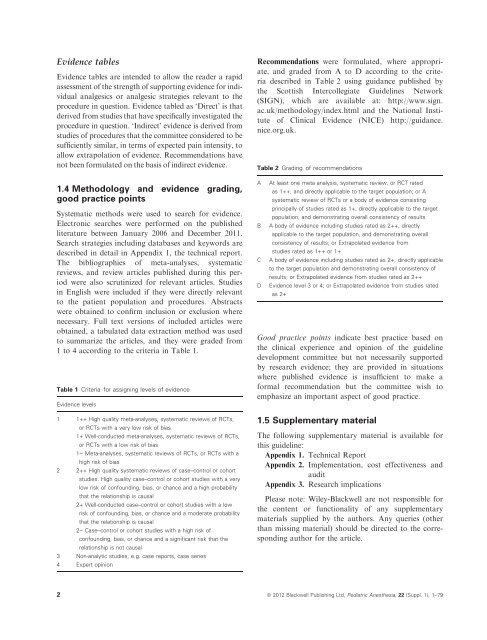Good Practice in Postoperative and Procedural Pain Management ...
Good Practice in Postoperative and Procedural Pain Management ...
Good Practice in Postoperative and Procedural Pain Management ...
You also want an ePaper? Increase the reach of your titles
YUMPU automatically turns print PDFs into web optimized ePapers that Google loves.
Evidence tablesEvidence tables are <strong>in</strong>tended to allow the reader a rapidassessment of the strength of support<strong>in</strong>g evidence for <strong>in</strong>dividualanalgesics or analgesic strategies relevant to theprocedure <strong>in</strong> question. Evidence tabled as ‘Direct’ is thatderived from studies that have specifically <strong>in</strong>vestigated theprocedure <strong>in</strong> question. ‘Indirect’ evidence is derived fromstudies of procedures that the committee considered to besufficiently similar, <strong>in</strong> terms of expected pa<strong>in</strong> <strong>in</strong>tensity, toallow extrapolation of evidence. Recommendations havenot been formulated on the basis of <strong>in</strong>direct evidence.1.4 Methodology <strong>and</strong> evidence grad<strong>in</strong>g,good practice po<strong>in</strong>tsSystematic methods were used to search for evidence.Electronic searches were performed on the publishedliterature between January 2006 <strong>and</strong> December 2011.Search strategies <strong>in</strong>clud<strong>in</strong>g databases <strong>and</strong> keywords aredescribed <strong>in</strong> detail <strong>in</strong> Appendix 1, the technical report.The bibliographies of meta-analyses, systematicreviews, <strong>and</strong> review articles published dur<strong>in</strong>g this periodwere also scrut<strong>in</strong>ized for relevant articles. Studies<strong>in</strong> English were <strong>in</strong>cluded if they were directly relevantto the patient population <strong>and</strong> procedures. Abstractswere obta<strong>in</strong>ed to confirm <strong>in</strong>clusion or exclusion wherenecessary. Full text versions of <strong>in</strong>cluded articles wereobta<strong>in</strong>ed, a tabulated data extraction method was usedto summarize the articles, <strong>and</strong> they were graded from1 to 4 accord<strong>in</strong>g to the criteria <strong>in</strong> Table 1.Table 1 Criteria for assign<strong>in</strong>g levels of evidenceEvidence levels1 1++ High quality meta-analyses, systematic reviews of RCTs,or RCTs with a very low risk of bias1+ Well-conducted meta-analyses, systematic reviews of RCTs,or RCTs with a low risk of bias1) Meta-analyses, systematic reviews of RCTs, or RCTs with ahigh risk of bias2 2++ High quality systematic reviews of case–control or cohortstudies. High quality case–control or cohort studies with a verylow risk of confound<strong>in</strong>g, bias, or chance <strong>and</strong> a high probabilitythat the relationship is causal2+ Well-conducted case–control or cohort studies with a lowrisk of confound<strong>in</strong>g, bias, or chance <strong>and</strong> a moderate probabilitythat the relationship is causal2) Case–control or cohort studies with a high risk ofconfound<strong>in</strong>g, bias, or chance <strong>and</strong> a significant risk that therelationship is not causal3 Non-analytic studies, e.g. case reports, case series4 Expert op<strong>in</strong>ionRecommendations were formulated, where appropriate,<strong>and</strong> graded from A to D accord<strong>in</strong>g to the criteriadescribed <strong>in</strong> Table 2 us<strong>in</strong>g guidance published bythe Scottish Intercollegiate Guidel<strong>in</strong>es Network(SIGN), which are available at: http://www.sign.ac.uk/methodology/<strong>in</strong>dex.html <strong>and</strong> the National Instituteof Cl<strong>in</strong>ical Evidence (NICE) http://guidance.nice.org.uk.Table 2 Grad<strong>in</strong>g of recommendationsABCDAt least one meta analysis, systematic review, or RCT ratedas 1++, <strong>and</strong> directly applicable to the target population; or Asystematic review of RCTs or a body of evidence consist<strong>in</strong>gpr<strong>in</strong>cipally of studies rated as 1+, directly applicable to the targetpopulation, <strong>and</strong> demonstrat<strong>in</strong>g overall consistency of resultsA body of evidence <strong>in</strong>clud<strong>in</strong>g studies rated as 2++, directlyapplicable to the target population, <strong>and</strong> demonstrat<strong>in</strong>g overallconsistency of results; or Extrapolated evidence fromstudies rated as 1++ or 1+A body of evidence <strong>in</strong>clud<strong>in</strong>g studies rated as 2+, directly applicableto the target population <strong>and</strong> demonstrat<strong>in</strong>g overall consistency ofresults; or Extrapolated evidence from studies rated as 2++Evidence level 3 or 4; or Extrapolated evidence from studies ratedas 2+<strong>Good</strong> practice po<strong>in</strong>ts <strong>in</strong>dicate best practice based onthe cl<strong>in</strong>ical experience <strong>and</strong> op<strong>in</strong>ion of the guidel<strong>in</strong>edevelopment committee but not necessarily supportedby research evidence; they are provided <strong>in</strong> situationswhere published evidence is <strong>in</strong>sufficient to make aformal recommendation but the committee wish toemphasize an important aspect of good practice.1.5 Supplementary materialThe follow<strong>in</strong>g supplementary material is available forthis guidel<strong>in</strong>e:Appendix 1. Technical ReportAppendix 2. Implementation, cost effectiveness <strong>and</strong>auditAppendix 3. Research implicationsPlease note: Wiley-Blackwell are not responsible forthe content or functionality of any supplementarymaterials supplied by the authors. Any queries (otherthan miss<strong>in</strong>g material) should be directed to the correspond<strong>in</strong>gauthor for the article.2 ª 2012 Blackwell Publish<strong>in</strong>g Ltd, Pediatric Anesthesia, 22 (Suppl. 1), 1–79
















